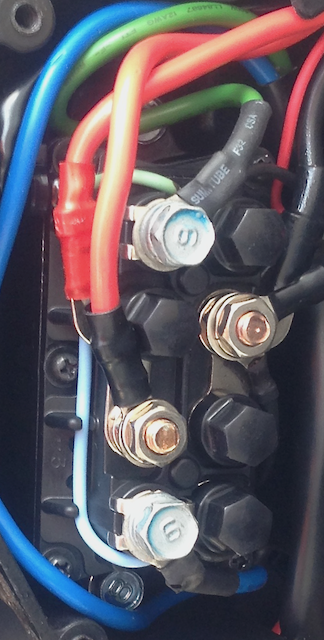I own a 2009, 75 hp, four stroke Yamaha outboard that is on a Bennington pontoon. The tilt and trim gauge (Faria) brand is not reading properly. The motor actually goes all the way up and all the way down but the gauge indicates it is only going about 1/2 way up and 1/2 way down. I took the gauge out and looked at it but it looks fine and it does not seem to have moisture in it. Is there a way to test the gauge? Is there something else that can be causing this? Thank you in advance for your response. The title should have read, "Tilt and Trim" and not "Title and Trim".
Announcement
Collapse
No announcement yet.
Title and Trim Gauage Not Accurate
Collapse
X
-
here's what Faria says about checking a gauge
have you had a look at the trim sender (sensor)?
the black plastic spring-loaded arm under the bracket?
easy to see with the boat out of the water, and the engine tilted up
in the water, not so much...Attached Files
-
Rodbolt,
here it is;
so they mean measuring at the full travel of the arm, its 238 ohms at one end, 378 at the other? is that right?
thanks!Attached Files
Comment
-
Nope. With the sender arm at one end of the arm travel the resistance should be between 9 ~ 11 ohms and at the other end of the arm travel the resistance should be 238 ~ 378 ohms. That is the check for the sender itself.Originally posted by fairdeal View PostRodbolt,
here it is;
so they mean measuring at the full travel of the arm, its 238 ohms at one end, 378 at the other? is that right?
thanks!
With respect to the gauge, if the sender is not connected at all the needle or bar scale should indicate full down trim. With the sender terminal grounded to a good ground source then the needle or bar scale should indicate full up trim.
Comment
-
I replaced our fuel gauge with a trim gauge. As Rodbolt noted, the sending unit at the outboard is a potentiometer. Mine is a simple spring loaded lever on the engine bracket with two screws. One has a sloppy slot for adjusting position that directly correlates to gauge needle position. The location isn't convenient for adjustment and trial and error got me close enough for my use.
Comment
-
Nope, it is simply a variable resistor. Has two input leads. On an F75 anyway. Some older Yamaha's do use three wire senders (and some earlier models use four wires) but not the OP's model.Originally posted by throrope View PostI replaced our fuel gauge with a trim gauge. As Rodbolt noted, the sending unit at the outboard is a potentiometer. Mine is a simple spring loaded lever on the engine bracket with two screws. One has a sloppy slot for adjusting position that directly correlates to gauge needle position. The location isn't convenient for adjustment and trial and error got me close enough for my use.
A potentiometer is a sort of variable resistor but acts a voltage divider. It has three input leads.
Potentiometer - Wikipedia, the free encyclopedia
Comment
-
Thanks - I got the variable resistor.Originally posted by boscoe99 View PostNope, it is simply a variable resistor. Has two input leads. On an F75 anyway. Some older Yamaha's do use three wire senders (and some earlier models use four wires) but not the OP's model.
A potentiometer is a sort of variable resistor but acts a voltage divider. It has three input leads.
Potentiometer - Wikipedia, the free encyclopedia
Comment
-
I own a Yamaha 4 stroke, 75 hp, 2009 outboard and the TT quit working tonight. When i push up or down on the shift lever TT button or the one on the engine I just heat a single click each time I push the button. Does anyone know how what is wrong and how I can fix it. Thank you in advance for reading my post and hopefully, telling me how to fix this.
I cant find out where to post a new question
Comment
-
that's OK.Originally posted by okeechobee View PostI cant find out where to post a new question
If you are getting the same click both at the remote control switch,
and the 'trailer switch',
then both switches are likely good.
If you are getting a click - but just a click -
for both up and down,
that's the sound of the relays actuating;
but since they are two separate relays,
that likely means the relays are OK
but the motor is bad.
The relay is on the front of the motor,
starboard side, under a plastic cover,
near the bottom.
The big red wires are unfused direct battery power -
so you may want to switch off, or disconnect the battery + cable
before you start messing with it.
The big blue and the big green wire are the t/t motor leads
if you remove them from the posts of the relay,
you can know that you are testing the motor directly:
connect one (either blue or green) to battery (+),
the other to battery (-)
the motor should run.

Comment

Comment